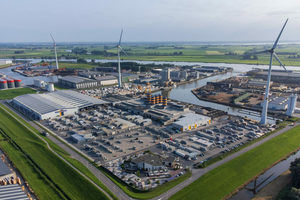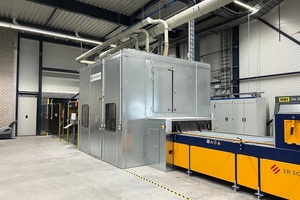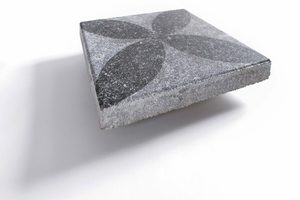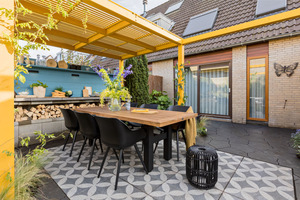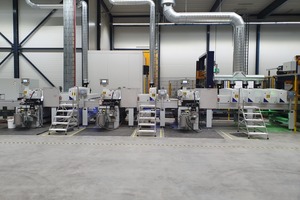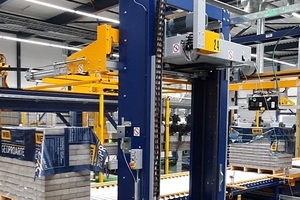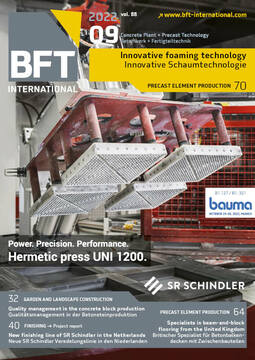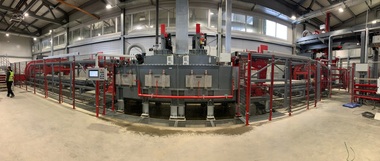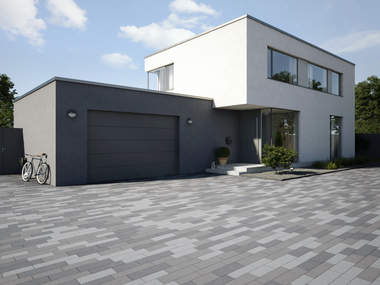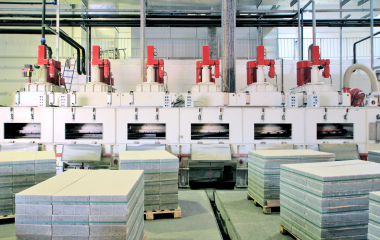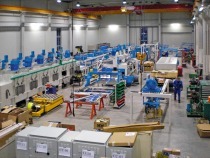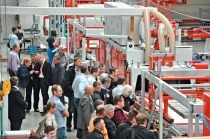New finishing line of SR Schindler in the Netherlands
The Dutch family-owned company MBI Machine B.V. has constructed a new finishing line at its Kampen site in order to be able to meet the needs and wishes of its customers even better. The contract for delivery, installation and commissioning of the new finishing line for the concrete slabs was awarded to the mechanical engineering company SR Schindler from Regensburg, which successfully commissioned the plant in 2021.
With over 75 years of experience, the Dutch family-owned company MBI Machine B.V. (MBI) has continuously expanded its production and growth. Today, the company employs around 400 employees at four sites and specializes in manufacturing high-quality products for private and public users. The state-of-the-art GeoProArte design technology enables MBI to harmonize the beauty of natural stone, wood, and other materials with a concrete tile. The latest decorative paving consists of a strong concrete carrier with a high-quality ceramic design. Thanks to this design technology’s large degree of design freedom, the team from MBI can implement individual customer wishes.
A new finishing line was constructed at the Kampen site in the Netherlands in 2021 better to meet the needs and wishes of the customer. The contract for delivery, installation and commissioning of the new finishing line for the concrete slabs was awarded to the mechanical engineering company SR Schindler from Regensburg, which successfully commissioned the plant in 2021.
Innovative printing technology for concrete products
The new finishing line includes the sub-processes of aging, curling, and printing and serves to expand MBI’s range of products sustainably. Also included in SR Schindler’s scope of delivery are the in-plant conveying and handling equipment and the packing.
The heart of the new finishing line is the printing line, which enables the family-owned company to print individually on concrete slabs and at the same time to combine extreme precision with the very high requirements for durability and suitability for daily use, such as color-fastness or abrasion resistance.
In addition to the short cycle time of 12 seconds per reference layer with the dimensions of 1,200 x 1,200 mm, the well-known durability and ease of maintenance of the machines were decisive factors for the order. This new finishing line was installed and commissioned by SR Schindler’s installation and service personnel.
The working width is between 800 x 800 mm and 1,250 x 1,250 mm, the smallest individual stone measuring 200 x 300 mm.
Construction of a new hall
An existing hall that houses the concrete slab production was supplemented by constructing a new hall for the GeoProArte finishing line. It was essential to design the hall so the products could be transported directly by belt conveyor to the new line.
The layer stacking device with a four-sided electromotive clamp removes the concrete slabs - delivered from the existing plant - from the belt conveyor and places them on the belt conveyor that feeds the new finishing line. The following layer pusher now formats the products, which are transferred in individual layers, into an endless row in which the products pass through the aging machine. The integrated foil dispenser prevents surface damage during this process so that only the edges are broken, and the stone surfaces retain their beauty. This foil is located between the products and the aging tools in the aging process and is conveyed synchronously with the products through the plant.
To protect the employees in the hall from the noise level caused by the aging machine, MBI opted for a separate soundproofing chamber in which the plant is housed.
A filter system extracts the dust created in this work step. Using sinter lamellas, the air can be cleaned so well that it can immediately be returned to the hall. This enables MBI to reduce the heat losses associated with exhausting the air into the open air, thus contributing to climate protection.
Curling
The products remain in the endless row following the aging process and are fed into the curling machine. MBI opted for a curling machine with two treatment tunnels and two brushes. This process removes surplus cement, resulting in the surface grain being worked out. This gives the machined products a slight gloss and a tangibly smoother surface. In addition, this process makes the product surfaces dirt and moisture-repellent and more resistant to slipping. Traces of treatment on the product surfaces can be avoided by the respectively opposed arrangement of the four brushes (the brushes are arranged in a V formation).
The plant is frequency-controlled and features automatic contact pressure regulation. The machine is controlled by a Siemens PLC S7-1500, including a control panel installed on the cantilever of the machine and a touch screen display. As with the aging machine, MBI opted for a sinter lamellas system to extract the dust and keep the air clean inside the hall. Curling, in which the product is freed of dust by the integrated high-pressure cleaning, is indispensable for the following coating process.
The following layer pusher with transfer table dissolves the existing endless row and subdivides it into individual layers again. These are now transported onwards on a slab conveyor. The subsequent double-layer pusher with a transfer table places the separate product layers on the belt conveyor, which is attached at a right angle and on which the products pass through the coating line. This specially developed double-layer pusher enables the short cycle times to be achieved.
Coating lines
MBI opted for a three-part coating line. At the start of the first sub-line, the individual concrete slab layers are heated to about 20 °C in the IR 1300 preheating tunnel, equipped with 21 radiators and an extraction tunnel. This process is essential because heating the products improves the adhesion of the primer to the products. Subsequently, the first liquid coating medium – the primer – is applied to the product from above by a foam rubber application roller driven by an infinitely controllable FC direct drive. This occurs in the RCLS 1300 roller application machine at a 5 – 25 m/min throughput speed. The primer, which in this case is white, additionally serves as the basis for the subsequent printing.
Next, the coated products are dried in the IR 1300 drying tunnel equipped with nine radiators. The concrete slabs subsequently pass once more through a roller application machine and a drying tunnel of the identical type. All these machines are likewise infinitely adjustable due to the frequency-controlled drives.
A further layer pusher with a transfer table now transports the individual layers to the customer-provided printer, where the individual desired motif is printed on the products at a throughput speed of 8 m/min.
Printed products
Subsequently, the individual layers are transported by a layer pusher with a transfer table onto a unique conveyor system with a length of almost 16 m. The products pass through a second coating line. At the start of this second sub-line, the freshly printed products are first dried in the IR 1300 drying tunnel with 8 radiators. Subsequently, a further coating takes place. Unlike Line I, however, this is not applied by an application roller but from above using a spraying process by the Robuseco Concrete SCE 1300 spray painting machine. The reason for this is the still sensitive print. It can be protected by spraying from the nozzles. Conversely, in the case of roller application, there would be a risk of destroying the print.
The following layer pusher with an automatically adjustable side clamp pushes the products onto the transversely installed slat conveyor. The almost 12-meter-long drying tunnel with 24 radiators (six groups of four lamps) is located there. This transverse installation shows that SR Schindler can offer tailor-made solutions with the standard components and thus implement individual customer wishes.
A further layer pusher with a transfer table and an automatically adjustable side clamp now convey the individual layers onto an additional belt conveyor, which is about 23 m long and moves through the third coating line.
First, the products pass through the e.a.sy-Dry JET 1300 nozzle dryer, where the solvent-free application media on the upper side are dried. This additional drying process ensures that the print is not negatively affected or damaged. A rubberized roller in the RCLS 1300 roller application machine applies a further liquid coating medium. The e.a.sy-Cure UV 1300 UV system hardens the applied lacquer in the further course. The last two steps, i.e., the application and hardening of another coat, are repeated twice in identical machines. MBI deliberately opted for this large number of repetitions because they offer the best possible protection of the print against damage such as scratches or wear. This is reflected, among other things, in the durability of the products.
All application rollers have a separate, infinitely adjustable FC direct-drive and, together with the quick-change system, offer a further advantage for the customers.
All three-part coating lines are centrally controlled, the individual machines being controllable via the bus system. The plant PC can be accessed via remote desktop, and the plant can thus be controlled or errors rectified. To protect the plant against unauthorized access, this must be released by an MBI employee.
Packing
Once the products have been coated, the individual layers are pushed by a layer pusher with a transfer table onto a belt conveyor, at the end of which the products are picked up by a layer stacking device, which consists of a trolley and a four-sided electromechanical clamp, and placed on pallets located on the pallet roller conveyor arranged in parallel.
The pallets are picked up by a pallet transfer device from a pallet magazine positioned alongside the line and placed on the pallet roller conveyor. This line is fed from behind. The manual filling of the pallet magazine and a pallet transfer device allow MBI to be flexible in pallet size.
The integrated intermediate layer dispenser automatically places a foil under the first layer and between the further layers. This protects against surface damage and tannic acid. The separate cover sheet feeder is reachable via the heavy load roller conveyor and subsequently applies the cover sheet to protect the packages against weather influences. MBI deliberately opted for a separate intermediate layer dispenser and cover sheet feeder due to the shorter cycle time. Finally, the packages are strapped horizontally and then vertically and transported by a heavy load roller conveyor to the end of the line. They are manually lifted off the line with a forklift truck.
Expectations fully met
The MBI management is delighted with the result of the collaboration with the companies involved in the project: “The finishing line from SR Schindler enables us to keep the desired low cycle times. The ease of maintenance and the durability of the machines also convinced us”, said Ton Pasnagel, Head of Production and Technology.
CONTACT
MBI B.V.
Taylorweg 10
5466 AE Veghel/Netherlands
+31 413 349 400
SR Schindler
Maschinen- und Anlagentechnik GmbH
Hofer Str. 24
93057 Regensburg/Germany
+49 941 69682-0

